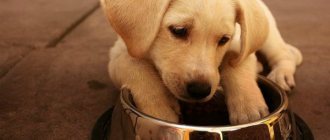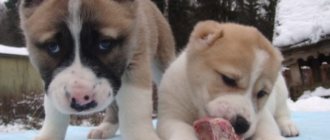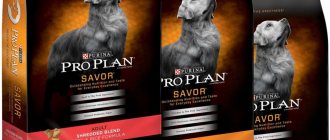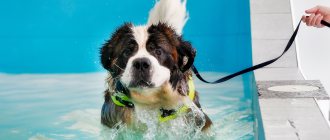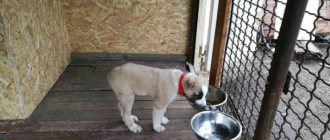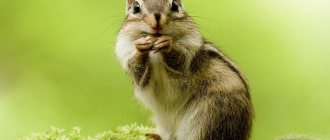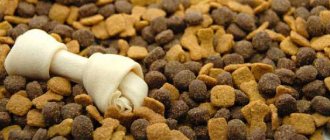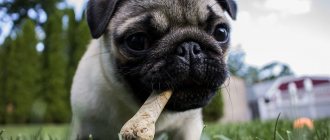Owners of Golden Retrievers know that this is the best breed of dog: smart, loyal and with the kindest soul. These people should be given the best. Including better food. We will talk further about what to feed the Golden Retriever.
1. General rules for feeding the Golden Retriever 2. Feeding schemes for the Golden Retriever 2.1. Dry food 2.2. Natural food 2.3. Feeding puppies and lactating bitches 3. Feeding a puppy after purchase 4. Proper nutrition for a golden retriever puppy: how to choose 5. Foods that should not be given to a retriever 6. Drinking water for a retriever 7. Feeding bowls
General rules for feeding a golden retriever
The question “natural menu or food” is an age-old question, but, according to dog breeders, there is not much difference. The main thing is to choose what your pet will like. Here are some basic principles.
- Give your retriever only fresh and high-quality food;
- Feed your pet only at strictly prescribed times and after walks. It is better not to have snacks between meals;
- If your pet refuses to eat, there is no need to force him. Better show it to the vet.
Diet of grown and adult Labradors
Labradors from one year and older are fed twice a day. Approximately follow the following calculations:
- an adult dog per day requires a volume of food equal to 4% of the animal’s weight - about 0.7-1.4 kg of food daily;
- amount of meat – 15 g per kg of weight;
- daily carbohydrate intake – 5 g per kg;
- The daily fat requirement is 2 g per kg.
The total amount of food is divided into 2 meals: morning and evening. The second feeding should be more filling: meat, vegetables, cereals. The morning menu consists of easily digestible foods - cottage cheese, eggs, kefir.
In between main feedings, you can treat your Labrador with treats, fruits, and mineral supplements. Their calorie content is included in the daily intake.
Indicative menu:
- in the morning – cottage cheese or omelet, fresh vegetables;
- in the evening - chopped beef (fish) and offal with cereals, boiled vegetables, herbs.
The caloric content of an adult Labrador's diet is regulated individually for each dog.
The volume of portions and snacks depends on the activity of the animal: service or hunting dogs receive 15-30% more protein products than pets.
The gender of the animal also matters (males are given 7-15% more food) and the time of year (in summer the amount of food is reduced by 15%).
Golden Retriever Feeding Plans
An adult dog needs to be fed twice a day. Older dogs can be fed once a day. Much depends on whether you and your pet have chosen a natural diet or food.
Dry food
The first thing you need to know is the composition of the feed. All ingredients are listed in descending order and by percentage. Animal proteins should be at the top. It is better to avoid food containing wheat (which most often causes allergies), corn and soy. Ideally, there should be two or more animal proteins. If animal protein is listed first and the next one is printed 8-9 in the list, there is little protein in the feed. Look for food where the first items in the composition are occupied by proteins.
Manufacturer's recommendations for the amount of food do not always correspond to reality: a dog can eat more or less. Divide the recommended amount of food into two or three meals and adjust the dosage to suit your retriever's needs.
What to feed a Labrador Retriever
Feeding a Labrador Retriever
It is recommended to feed an adult dog 2 times a day. Owners set their own feeding time for their pet, depending on their daily routine. If the dog refuses food for any reason, you must call a veterinarian - the animal may be sick.
In order for the dog to always remain healthy and beautiful, in addition to meat and various types of ready-made food, it is necessary to include food of plant origin, dairy products and mineral mixtures in its diet.
IT IS NOT RECOMMENDED TO FORCE YOUR DOG TO EAT WHAT IT DOESN'T WANT
The Labrador Retriever should be fed meat (tendons, heart, lungs, kidneys, liver, stomach), fish (cod, catfish), vegetables (cabbage, turnips, onions, pumpkin, carrots), fruits, cereals (semolina, rice, millet, oats, rye, buckwheat) and milk mixtures. THE DIETS OF LABRADOR PUPPIES UP TO 3 MONTHS INCLUDE NOT FOOD, BUT MEAT, DAIRY PRODUCTS, CEREAS AND CANNED PEACES, DESIGNED SPECIFICALLY FOR PUPPIES Moreover, meat products are best given to dogs in the evening, and milk and vegetable mixtures are best given to dogs in the evening. in the morning. During feeding, the retriever may dirty the floor. To avoid this, it is recommended to place a newspaper or a board with a cut hole for the bottom of the bowl under the food bowl. Determining how much food your pet needs daily is quite simple. It is necessary to carefully observe the pet for 2-3 days. If the dog eats greedily and licks an empty bowl for a long time, it means that there is not enough food for it, but if the animal eats slowly or its stomach becomes very bloated while eating, the retriever is overeating. The dog’s daily diet must correspond to age and activity she exhibits.
Sources of fats for a Labrador A complete diet for a Labrador must include fats of both plant and animal origin.
BUTTER IS A VALUABLE SOURCE OF ANIMAL FAT
A deficiency of fat in the diet of a young dog can lead to undesirable consequences: slower growth and development, skin diseases, vitamin deficiencies, disruption of normal coat pigmentation and other pathological conditions. However, excess fat in the body is also harmful to the animal, which can lead to obesity and some other diseases. A valuable source of animal fats are products such as goat and cow milk, sour cream, and butter. They are distinguished by a high content of vitamin A, as well as other substances useful for the body of a growing pet: choline, tocopherol, phosphatides. Vegetable fats are found in cereals and vegetable oil.
The composition of vegetable oil includes polyunsaturated fatty acids and vitamin E - vital components with which animal and dairy fats are enriched to a lesser extent. The presence of polyunsaturated fatty acids in a dog’s body contributes to its rapid growth, increased immunity, strengthening the walls of blood vessels, and activation of metabolism in the body animal. It is necessary to add products such as butter, vegetable oil or rendered beef fat to the dog's food, especially in soups and cereals prepared without the addition of milk. A sign that the pet is receiving the optimal amount of fat for it is the attractive appearance of the coat . Smooth, even, thick and shiny fur also indicates a sufficient amount of vitamin E in the animal’s body.
Sources of vitamins for Labrador Retrievers Vitamins are vital for the dog’s body. Their deficiency leads to a decrease in the vitality and resistance of the animal's body, and also negatively affects its reproductive abilities. Depending on the ability to dissolve, vitamins are divided into fat-soluble (A, D, E, K) and water-soluble (C, group B).
FRUITS AND VEGETABLES CONTAIN LOTS OF VITAMINS ESSENTIAL FOR DOG HEALTH
The owner of a dog needs to know what vitamins are necessary for his dog.
Vitamin E. Needed for normal reproductive activity. Vitamin H. Affects the reproductive abilities of animals, as well as fat metabolism and the normal functioning of the skin. Vitamin C. To maintain the natural balance of substances in the body, the dog needs to consume a certain amount of ascorbic acid daily, while in stressful situations, the norm of vitamin C increases by 2, and during pregnancy - by 3 times. Vitamin A. Necessary for growth, improvement of reproductive functions, normal functioning of the nervous system and good vision of the pet. Vitamin B2. It is part of enzymes that regulate oxidative processes in cells. Vitamin B2 is also involved in carbohydrate, protein and fat metabolism. Vitamin B3. Participates in the synthesis of fats and proteins and affects growth, coat, skin tissue and the functioning of the nervous system. Vitamin B6. Part of the enzymes involved in the breakdown of amino acids. This vitamin takes an active part in protein metabolism and affects the content of hemoglobin in the blood. Vitamin B9. Promotes normal development of the coat, stimulates and regulates the process of hematopoiesis, preventing anemia. Vitamin B12. Plays a huge role in the body's use of animal protein and is involved in the metabolism of certain amino acids.
PUMPKIN IS A SOURCE OF MANY VITAMINS
Vitamin D. Participates in phosphorus-calcium metabolism in the body of animals, ensures normal growth and development of bones. When giving animal owners any recommendations on feeding, experts take into account such factors as the age, breed and temperament of the dog, the climatic conditions in which it contained, etc. Vitamin K. Promotes normal blood clotting. Unfortunately, there is no consensus on the exact amount and types of vitamins that a dog needs for normal functioning. Vitamin A is necessary for young dogs. Its deficiency has an extremely negative impact on the health of the animal, negatively affects the functioning of the digestive tract, and a deficiency of B vitamins leads to dysfunction of the immune system. If there is a lack of vitamin A in an animal’s body, its eyes begin to water, digestion and the development of reproductive organs are impaired. Also the activity of the upper respiratory tract may be disrupted. A lack of vitamin E (tocopherol) leads to the dog’s coat losing its shine and looking disheveled. If there is a lack of tocopherol in the animal’s body, irreversible changes in the muscles can occur and infertility may develop. A lack of vitamin C weakens the immune system, and this leads to the occurrence and development of many diseases, in particular scurvy. Symptoms of the disease: depression, loose teeth, sore gums. In order to prevent scurvy, it is recommended to give the dog daily ascorbic acid dissolved in drinking water. Normal development of the skeleton of puppies is possible only when vitamin D, which is responsible for calcium-phosphorus metabolism, is present in their body in sufficient quantities. Calciferol prevents the development of rickets in puppies. Vitamin D deficiency leads to dysfunction of the musculoskeletal system, curvature of the paws, spinal column, as well as delayed development and growth of the dog.
FRESH GREENS – A VALUABLE SOURCE OF VITAMINS
An excess of retinol in an animal’s body leads to accelerated bone growth, resulting in improper skeletal development. A lack of vitamin B1 (thiamine) in a dog’s body leads to general weakness and digestive disorders. A deficiency of pantothenic acid leads to liver dysfunction, and an insufficient amount of folic acid leads to anemia .When a dog lacks vitamin B6 (pyridoxine), it experiences a sharp decrease in body weight and the functions of the musculoskeletal system may be impaired. A lack of vitamin B12 (cyanocobalamin) leads to baldness of the animal. A deficiency of vitamin K (phylloquinone) develops as a result of long-term treatment of the dog with antibiotics and leads to loss of appetite and increased irritability. To compensate for vitamin deficiencies, especially in spring, dogs’ diets include a supplement consisting of a mixture of finely chopped onions, spinach, dandelion, parsley, lettuce, and nettles. Before feeding the puppy, nettles should be scalded with boiling water and cooled, and dandelion leaves should first be immersed in salted water for several hours to remove bitterness from them. Foods containing a large amount of vitamins include fruits, vegetables (carrots, turnips), herbs (parsley, lettuce, spinach, dandelion leaves, garlic, onion), cereals (buckwheat, oatmeal, rice, millet).
OLIVE OIL CONTAINS HIGH QUANTITIES OF VITAMIN E
Fruits and vegetables cannot be called staple foods, but they must be included in a dog’s diet. They are a source of many vitamins: nicotinic acid, carotene, vitamins C and K, folic acid, as well as mineral salts: potassium, iron, magnesium, phosphorus. As a treat, the animal should be given dried fruits - raisins, dried apricots, prunes and apples. They are rich in vitamins and dogs really like them. Dried fruits can be soaked in warm water and crushed added to porridges and salads. Dogs willingly eat not only vegetables, but also fruits. Vegetables can be given to your dog either raw or processed. To pamper your pet with an original vegetable salad, it is recommended to take some peeled turnips, grate them, and season the resulting mass with kefir and vegetable oil.
FOR PREPARATION OF FEED ONLY FRESH PRODUCTS ARE USED
From 2 months of age, you can give your baby carrots, grated on a fine grater and mixed with sour cream or a small amount of vegetable oil. It is allowed to include mashed apples and any berries that the dog likes in his diet (the seeds should be removed first). Many animals happily eat strawberries and raspberries, as well as apricots, pears, cherries, cherries, and watermelons. It is necessary to add greens to the retriever’s food daily. Garlic is especially useful and can serve as an ideal remedy for worms. One crushed clove is mixed with the main feed. In winter, garlic supplement serves as an additional source of vitamins. A proven remedy against worms is raw pumpkin seeds, peeled. Boiled pumpkin pulp and beets are rubbed through a sieve or crushed on a grater and given to the dog along with porridge. It is advisable to feed potatoes only raw. Turnips, cabbage, zucchini, and rutabaga are usually stewed or boiled and given to the dog as an addition to meat food. In addition, these vegetables, as well as cucumbers and greens, can be included in the pet’s diet without heat treatment, but only by peeling and cutting into small pieces To feed your dog, you can also prepare a mixture of porridge and boiled vegetables. For stewing, weak meat broth or water is usually used.
Balanced nutrition for an adult Labrador Retriever The correct diet is compliance with the frequency and quantity of feedings, compliance with the norms of food consumed by the dog, its age, health status and energy expenditure. The daily diet is determined not only by age, but by other factors. The main ones among them are the pet’s gender, its height, weight, fatness, place of detention, as well as the work performed by the dog and the physical stress it experiences.
Components harmful to the health of a Labrador Retriever The diet of dogs living within the city is often incomplete because it contains insufficient amounts of vitamins and minerals. The food of urban residents contains a large number of different preservatives, flavorings and dyes. They can cause serious damage to the dog's health. First of all, this applies to various types of sausages, sausages, canned food and sweets. Meat products are often processed with chemicals that are not absorbed by the dog’s body. Sweets contain sugar, cocoa and menthol, which negatively affect the health of the animal. First of all, the excretory organs are affected, which leads to the development of uremia and can be fatal. Recent studies conducted by specialists in Europe and the USA have confirmed that more than 50% of dogs living in urban areas die as a result of the development of uremia. An analysis of these data by Russian veterinarians showed that proper feeding of animals would significantly prolong their life, reducing the risk of developing the disease. Typical Labrador diets When calculating the optimal amount of food, it is necessary to take into account the activity of the pet. The Labrador Retriever moves a lot, so it spends a lot of energy. The diet of a 3-month-old puppy should be as follows: • breakfast: 200 ml of formula, crackers; • lunch: 3 tbsp. l. chopped beef; • dinner: 4 tbsp. l. chopped beef, 2 crackers, 2 tbsp. l. boiled mashed vegetables; • late evening: 1 tbsp. l. milk formula; • throughout the day: vitamin supplements. At the age of 5 months: • breakfast: 200 ml of milk formula, crackers; • lunch: 4–5 tbsp. l. chopped beef; • dinner: 8 tbsp. l. chopped beef, crackers, vegetables;• late evening: 200 ml of formula;• throughout the day: vitamin supplements. At the age of 7–10 months:• breakfast: 1 liter of milk, 50 g of cottage cheese, crackers, 1 boiled egg;• dinner: 450 g of chopped beef, crackers, vegetables. At the age of 1 year, the diet changes depending on the load and activity of the dog. Special attention must be paid to the preparation of dog food for both hygienic and medical reasons. During heat treatment, products lose a significant part of their nutrients, such as vitamins, which are quickly destroyed. Proteins are destroyed during cooking and frying, and mineral elements dissolve in water during the cooking process. But the statement that it is best to feed a dog raw food is incorrect. Raw food, especially meat and fish, may contain parasites or their larvae, which can only be destroyed through careful heat treatment. Ready-made food is no less dangerous if it has been in a warm room for a long time and has begun to deteriorate. Dogs quickly get used to eating at a certain time, so it is not recommended to change the feeding regime without good reason - this can become serious stress for a Labrador. Such food is a source of pathogenic microbes that enter the animal’s body along with spoiled food and provoke the development of a number of serious diseases or poisoning. It is recommended to feed adult animals 2 times a day. The number of feedings can be increased only for pregnant bitches. It should be borne in mind that in winter the dog eats much more than in summer. For owners of old pets, it is best to distribute the entire daily amount of food into equal portions and feed their charges 3 times a day. As the dog ages Metabolism slows down, so it is recommended to give her food after returning from a walk or after physical activity, when energy is consumed with greater intensity. A gentle diet serves to prevent diseases such as volvulus, which is often observed in aging Labrador retrievers. The temperature of food for your pet should be at room temperature (18–20 ° C). Do not feed your pet hot or cold food. When a dog is eating, it should not be distracted under any circumstances: by calling it by name, stroking it or cleaning it. You cannot train your pet to beg for handouts while the owner is eating. A dog should not take food from strangers. It should also be remembered that the animal should not be fed leftover food that is unsuitable for humans. Even if the food contains all the minerals, vitamins and nutrients the dog needs, it needs to be given vegetables and raw cartilage bones from time to time. Eating such bones once a week relieves your pet of the tartar that forms when feeding dry food. If your dog shows typical signs of protein poisoning, you should switch the animal to a vegetable diet for 2-3 weeks.
Proper nutrition for a golden retriever puppy: how to choose
At two to three months, the puppy needs to be fed 6 times. Until the baby is five months old, we feed him 4 times a day. At six months you can switch to two meals a day. Before permanent teeth appear, babies will definitely need yogurt, kefir or cottage cheese every day. Milk is allowed up to six months.
As for the diet, it must contain cereals:
- Millet;
- Rice;
- Buckwheat.
It is better not to feed puppies pearl barley, semolina, barley and wheat porridge, and market mixtures. The life of a puppy is unthinkable without meat. It is best to give:
- Turkey;
- Chicken;
- Veal;
- Beef;
- Rabbit meat;
- Horse meat;
- Nutria.
In any case, the meat should not contain tubular bones. In addition, pork is not recommended for puppies. The ideal processing option is boiling, or defrosting in the microwave after deep freezing. Eggs can be given either raw or boiled, but rarely. We give the puppy fish only without bones. Instead of bones, it is better to take cartilage and joints. From fats, butter and any vegetable oil are allowed, but not margarine.
In total, the puppy should receive 300 g of meat per day and 0.5 kg of milk porridge per day. Vegetables and fruits are needed in the amount of 100 g, fermented milk products - about 150 g.
Is it possible to feed a retriever puppy dry food? It is possible, but there are several conditions. So, the food should be specialized, “for children”. It is better to choose those belonging to the minimum super premium category. The best meat in puppy food is lamb.
As for eggs, only yolks can be present in feeding a Labrador Retriever
They can be added both to porridge and to the protein part, one piece per week. It’s not worth giving more, since the breed is always at risk of obesity, and the yolk is quite high in calories.
Vegetables and fruits are served either finely chopped or grated. In order to reduce the risk of developing allergies, all vegetables, fruits and herbs should be given gradually, checking the body's reaction to the product. Owners who give their retriever raw meat should pay special attention to pumpkin. She is a good advocate for internal parasite control. If your dog does not eat raw chopped pumpkin, then you can try baking it without everything and feeding it with fermented baked milk.
Labradors are perhaps the only breed that can be given salt. It is advisable that it be sea salt, in small quantities and as a rare but regular addition to food.
It is strictly forbidden to feed a Labrador at home with food from your table; of course, it is not the common foods that are harmful to dogs, but the way they are prepared. Also not allowed: fatty meat, bones, legumes, semolina, potatoes, cabbage, sausages, chocolate and any sweets, milk, bread, citrus fruits, avocado and broccoli. Some products simply have a strong laxative property for the breed, some of them depress the health of the skin and fur, and some are simply contraindicated, as they lead to severe indigestion or contribute to food poisoning.
As treats, you can give the breed pieces of pear, special cookies and biscuits for dogs, dried crackers, and pieces of parmesan. But remember that this should be in very small quantities, as the breed is famous for being a great manipulator. Treats should be given as a reward for following commands, and not just as a snack between feedings. It is very easy to overfeed a Labrador, so do not be lazy to weigh portions; an overfed Labrador can acquire a bunch of diseases that will be difficult to cure by simply losing weight.
Vitamins for a Labrador should be chosen in accordance with the recommendations of veterinarians, since the breed is very specific in terms of nutrition and absorption of vitamins.
What should natural food include?
How to feed a Labrador natural food if the dog does not like raw meat? In this case, you need to give boiled or steamed meat. It is important and necessary to give stringy pieces of meat so that your pet chews them.
Offal must be cooked thoroughly and for a long time. The stomach (tripe) is given to the dog raw - it is very healthy and is a delicacy made from offal.
Natural food must be freshly prepared. It can be from the refrigerator (no more than two days) and heated.
Food for Labrador, necessary products in the diet:
- meat (beef, veal, lamb (remove fat), horse meat, rabbit, turkey);
- liver, kidneys, heart, stomach;
- vegetables (carrots, pumpkin, cauliflower, beets, zucchini, turnips);
- 1 raw potato per week;
- fruits - apples, pears, apricots;
- fresh greens, spinach, lettuce, onions, garlic;
- dairy products (kefir, sour cream, cottage cheese, yogurt);
- vegetable oil (ordinary, flaxseed or olive);
- fish (sea, boiled, boned);
- cereals (buckwheat, rice, oatmeal);
- cartilaginous bones;
- eggs (once a week - in the form of an omelet or boiled);
- water (always keep it fresh).
Prohibited products:
- sausage, frankfurters;
- smoked, fried foods;
- sweet, salty, hot seasonings;
- pasta and legumes;
- lamb with fat, pork;
- bones – a dog may choke or swallow a sharp bone, causing intestinal ruptures;
- corn;
- milk (in adult dogs it causes diarrhea);
- baking (causes bloating).
Labrador: what to feed an adult dog (sample menu for a week)
| Days of the week | Approximate diet |
| Monday | Veal (boiled) - 300 g; Rice (boiled) - 200 g; Carrots (boiled, grated) - 100 g; Cottage cheese (whole) - 150 g; Parsley (finely chopped) - 50 g. |
| Tuesday | Chicken (or turkey) - 300 g; Buckwheat (boiled) - 200 g; Pumpkin (baked or boiled) - 150 g; Ryazhenka (yogurt) - 100 g; Yolk (chicken) - 50 g. |
| Wednesday | Fish (hake or mackerel variety) - 300 g; Millet (boiled) - 250 g; Zucchini (raw, grated) - 100 g; Sunflower or olive oil - 25 g; Parsley (finely chopped) -25 g; Yogurt (or fermented baked milk) -100 g. |
| Thursday | Tripe (beef or lamb raw) - 300 g; Rice (boiled) - 200 g; Apple and carrots (raw, grated) - 150 g; Cottage cheese (whole) - 150 g. |
| Friday | Turkey (or chicken, raw) - 300 g; Buckwheat (boiled) - 200 g; Pumpkin (baked) or zucchini - 200 g; Ryazhenka (or yogurt, yogurt) - 100 g. |
| Saturday | Liver, kidneys, lungs - 300 g; Rice (boiled) - 200 g; Carrots, beets (raw, grated) - 200 g; Ryazhenka (yogurt) - 100 g. |
| Sunday | Buckwheat (boiled) - 200 g; Mackerel - 300 g; Yogurt - 150 g; Yolk (chicken or quail) - 100 g; Pumpkin (raw, grated) - 50 g. |
Labrador: what to feed during the week (example)
Features of the breed that are taken into account when feeding
When compiling a menu for a Labrador, specific breed characteristics are also taken into account.
Gluttony.
These dogs are ready to eat endlessly. Even if the dog has just eaten a couple of bowls of meat, he will not refuse another pack or two of his favorite treats. Owners feel as if their pets are always hungry and overfeed the animals. Therefore, it is important to clearly define the daily amount of food (main feedings and snacks) and not deviate from it.
Labradors are prone to obesity
Prone to obesity, diabetes and hip dysplasia.
This is a vicious circle: Labradors are genetically predisposed to excess weight, which leads to problems with the musculoskeletal system and the thyroid gland. It is difficult for an already sick dog to lose weight. So it’s better to be strict and not give your dog his favorite cookies again than to stop the symptoms later.
Predisposition to food allergies.
New products or ready-made food are introduced gradually, carefully observing the reaction and condition of the animal. It is advisable to exclude common allergens from the diet: soy, corn, wheat, chicken, any food with chemical preservatives, dyes, etc.
Labradors often have cases of stomach and intestinal volvulus.
They cannot be walked immediately after eating - the pet needs to rest for 1-2 hours. It’s even better to take your pets outside before feeding.
Raising a healthy Labrador is not easy: you will have to carefully select the diet, calculate calorie content, strictly control nutrition and not give food in excess of the norm. But the effort is worth it: by adhering to proper feeding, you will get an active pet that is not familiar with diseases.
You may also be interested in:
- What is the difference between a Labrador and a Golden Retriever?
- DIY homemade treats for your pet
Feeding a puppy and an adult dog
There are two main types of feeding animals - home-made food (in the language of canine slang, “natural food”) and industrially produced food (respectively, “dried food”). In my opinion, both options are acceptable if they are a) of the highest quality, b) suitable for a particular dog.
The term “suitable” means in this context that the dog, which is fed one way or another, is in excellent condition, has healthy, clean skin, shiny coat, clear eyes, and normal bowel movements.
If the dog has any deviations from the state of well-being: skin rashes, it itches, its eyes “run”, the molting period is prolonged and the coat is in poor condition, redness, rash and excess ear discharge are observed in the ears, the stool is unstable, the dog too thin, etc. - this is a reason, firstly, to get tested, and secondly, to review the diet in the direction of changing it.
homemade diets
For home diets, one very general rule can be given: half the diet should consist of meat products (at the rate of 10-20g per 1 kg of weight for an adult dog), 1/4 of the diet should be cereals, 1/4 of the diet should be vegetables.
Meat products are beef (not tenderloin, but meat with veins and cartilage, meat trimmings, flank, etc.) and beef by-products (liver, lungs, kidneys, tripe), lamb, turkey, chicken, rabbit. Cereals - rice and buckwheat. Vegetables - cabbage, carrots, turnips, beets, zucchini, etc.
Thick porridge is cooked from cereals, stewed vegetables and meat (either raw or also stewed) are added to it.
Fermented milk products (cottage cheese, kefir, fermented baked milk) and eggs can also be added to the diet.
industrial rations
Industrially produced feed can be divided into three main categories: economical, regular, premium and super-premium.
Feed in the “economical” category is made from the most accessible and cheapest raw materials. Manufacturers of these feeds do not always ensure that the feed meets the physiological needs of animals at different periods of life. “Economy” foods include: Chappie, Pedigree, etc.
Food in the “regular” category has a variable composition of ingredients. Some ingredients (table salt, calcium phosphate, etc.) are standard, while the content of others (fish, meat, offal, grains, bone meal) varies depending on their availability. This circumstance may affect the quality of the feed. “Regular” foods include: Friskies, Darling, etc.
“First-class” food is fully balanced in accordance with the optimal needs of animals and adapted to certain age periods and the physiological state of animals. Only high-quality ingredients are used in their preparation.
“First-class” food is divided into 2 levels of food: premium and superpremium. Premium level food is Pronature, Top Winner, etc. Super-premium level food is 1st Choice, Bosch, Purina, Royal Canin, etc. There are series of “first-class food” that combine both premium and super-premium class (for example, Happy Dog, Bosch).
Feed additives.
No matter how excellent food is given to a dog, due to climatic conditions, poor water quality, and individual needs, a lack of vitamins and minerals may occur in its body. To prevent this, it is advisable to supplement the diet with mineral and vitamin supplements, in accordance with the dog’s needs. Mineral and vitamin supplements of the “Canvit”, “8 in 1”, “Polidex” series, etc. have proven themselves well.
Feeding regimen
? from 2 to 4 months - 4-5 times a day,
? from 4 to 6 months – 3-4 times a day,
? from 6 to 9 months – 3 times a day,
? after 9 months – 2 times a day.
? The dog should always be fed only after a walk
? The dog should always have free access to water.
a little from practice
I feed my dogs prepared “first-class” food, and I recommend that puppy owners do the same, at least until the puppy reaches the age of 1 year.
But if for some reason you are a categorical supporter of “natural feeding”, this is one of the options for the daily diet of a Golden Retriever puppy. Please note that this is an approximate daily diet.
Approximate daily diet for a Golden Retriever when fed natural products
(according to M. Kirzhner, from the book Breeding dogs of popular breeds. Rostov-on-Don, publishing house Phoenix, 2002)
2-3 months (number of feedings – 5 times a day)
Source
Dry food: how to choose the right one?
For Labradors, they buy holistic or super-premium food. Products of other categories (premium, economy) will not provide the dog with adequate nutrition: it contains little meat, a lot of grains, and contains allergenic and harmful components (soy, chemical additives, etc.).
Labradors need food labeled “for large dogs.” You can also select specialized ready-made diets for pregnant, active or, conversely, sedentary dogs, etc.
When choosing food, take into account the breed’s propensity for allergies, obesity and joint diseases.
Optimal food for Labradors:
- with reduced fat content;
- no corn, gluten, soy, wheat, egg;
- with natural preservatives – tocopherols, etc.;
- with glucosamine, L-carnitine, chondoprotectors;
- medicinal herbs and fruits to normalize metabolism and the functioning of the gastrointestinal tract.
List of the best dry food for adult Labradors:
- Acana Grass-Fed with Lamb;
- Advance for adult Labradors;
- Eukanuba Breed Specific Dry for Labrador Retrievers;
- Grandorf with lamb and rice for large adult dogs;
- Orijen grain-free for senior dogs;
- Applaws for Large Breed Adult Dogs with Grain-Free Chicken;
- Wolfsblut Green Valley for adult dogs, grain-free.
What to feed a Labrador puppy at 1, 2, 3 months at home?
If a puppy appeared in your house immediately after weaning from its mother, then what should you feed your Labrador Retriever?
You can choose your own feeding option. At first, babies are fed liquid cereals and dry food, which is soaked in kefir or natural yogurt. But try not to keep your baby exclusively on dry food.
The puppy is given food in a bowl and removed after 15 minutes . If he didn't finish it, it was an excess of food.
There should be breaks between feedings - the puppy should not constantly run to the bowl in which food remains.
In addition, puppies are fed the following foods:
- fish (sea) – boiled and deboned;
- cereals – rice, buckwheat, oatmeal (with the addition of a few drops of vegetable oil);
- carrots, cabbage, zucchini, cucumbers, pumpkin, potatoes (raw, no more than 1 per week), turnips, beets (a little). All vegetables are grated.
- dairy products – kefir, natural yogurt, cottage cheese;
- 1 boiled egg per week or raw yolk;
- vitamins prescribed by a veterinarian.
- calcium, which can be given in the form of ready-made supplements or the shells can be dried in the oven, crushed and the resulting powder can be added to cereals and yogurt (kefir);
- finely chopped fresh herbs (lettuce, dill, parsley) - add to porridge;
- water – you need to refresh the water in the bowl throughout the day.
